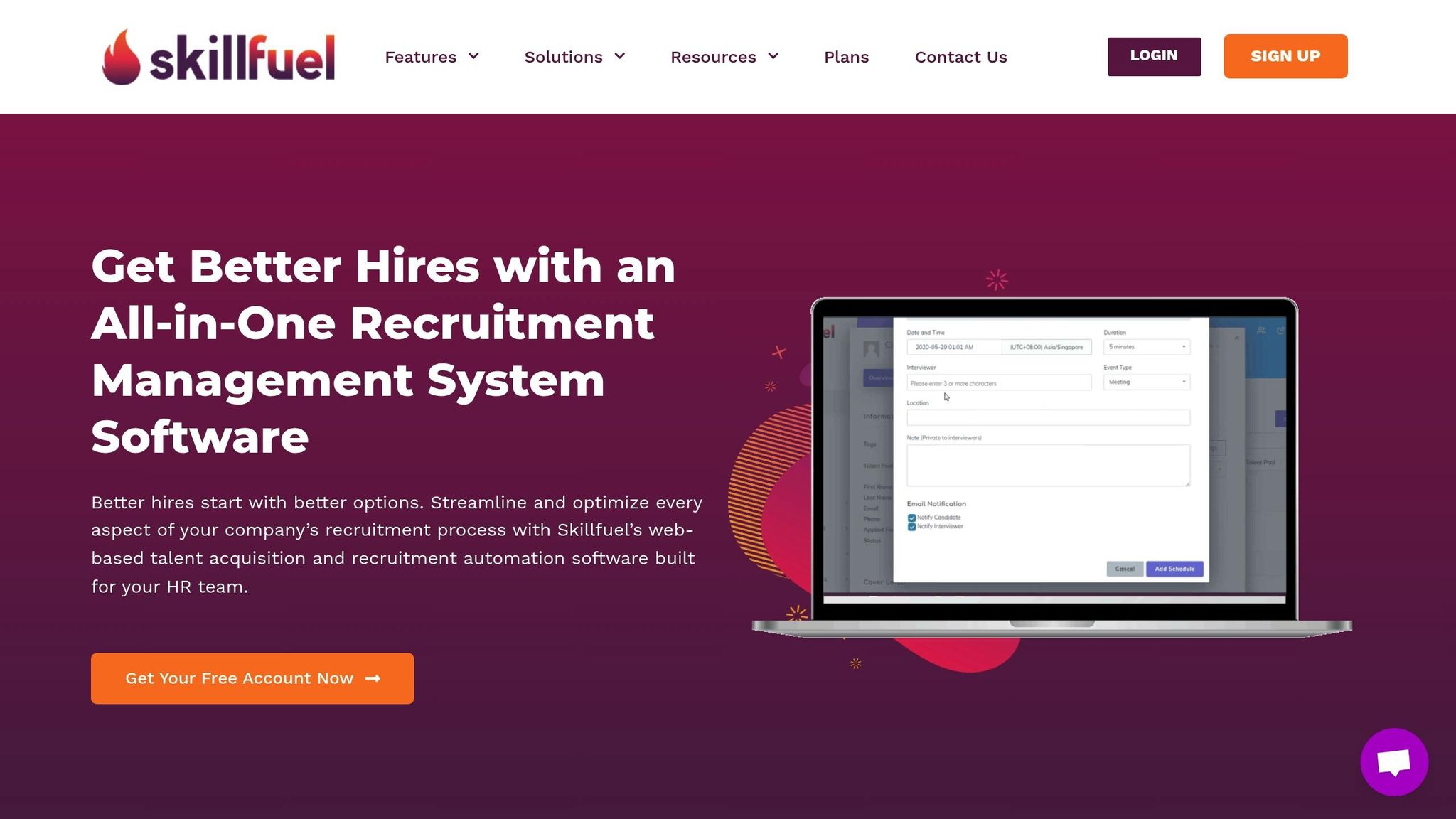Applicant Tracking Systems (ATS) are tools designed to simplify hiring by automating tasks like resume sorting, interview scheduling, and candidate communication. They save time, improve hiring decisions, and enhance the candidate experience. With features like analytics, job posting integrations, and workflow management, ATS platforms help recruiters focus on finding the right talent.
Key takeaways:
- ATS software automates repetitive hiring tasks, reducing time-to-hire by up to 60%.
- 98.4% of Fortune 500 companies use ATS for efficient recruitment.
- Platforms like Skillfuel offer tools for tracking applicants, managing workflows, and ensuring compliance with hiring regulations.
- Data-driven insights from ATS tools improve candidate quality and streamline decision-making.
Whether you’re a small business or a large organization, adopting an ATS can transform how you hire and manage talent.
Key Features and Functions of Applicant Tracking Systems
Core Features of an ATS
Modern Applicant Tracking Systems (ATS) come packed with tools designed to simplify and speed up the hiring process. In fact, 86.1% of users have reported a faster recruitment timeline after implementing an ATS. Here’s what makes these systems so effective:
Resume parsing takes the grunt work out of sifting through resumes. It automatically extracts key details – like names, contact information, work history, education, and skills – and organizes them into searchable fields. This means recruiters can quickly filter candidates by criteria such as experience or specific qualifications, saving countless hours.
Candidate management ensures every applicant has a detailed profile, tracking their journey through each stage of the hiring process. Built-in communication tools allow for both individual and bulk messaging, making it easier to stay in touch and ensure no one falls through the cracks.
Job posting integrations let recruiters post openings across multiple platforms – job boards, company websites, and even social media – with just a few clicks. This broadens the reach and attracts a more diverse pool of applicants.
Interview scheduling is another time-saver. These tools sync with popular calendars like Google Calendar and Outlook, handling invites, reminders, and rescheduling. This eliminates back-and-forth emails and reduces scheduling conflicts.
Analytics dashboards provide insights into hiring metrics like time-to-hire, cost-per-hire, and the effectiveness of different sourcing channels. These reports help recruiters identify what’s working and where improvements are needed.
Platforms like Skillfuel build on these core features, pushing recruitment automation to the next level.
How ATS Features Make Recruitment Easier
ATS tools are designed to tackle common recruitment challenges, offering greater visibility into the entire hiring process and ensuring critical steps aren’t missed. For example, real-time calendar syncing prevents scheduling mishaps, while automated communication keeps candidates informed and engaged.
From the moment someone applies, the system can send personalized acknowledgment emails, provide updates at key milestones, and even deliver rejection letters with constructive feedback. This level of communication not only improves the candidate experience but also strengthens the employer’s reputation.
Customizable workflows are another standout feature. These can be tailored to fit a company’s specific hiring process, whether that involves multiple interview rounds or unique approval steps for certain roles. This adaptability ensures the system aligns with an organization’s operations and values.
The results speak for themselves. After adopting ATS technology, 78.3% of users reported improvements in the quality of candidates, while 78% of recruiters noticed better hires overall. These outcomes are driven by more effective screening tools, consistent evaluation processes, and detailed candidate profiles that can be revisited for future opportunities.
Skillfuel‘s ATS Features
Skillfuel builds on the basics, offering advanced tools designed to meet today’s recruitment demands. For example, its Kanban-style workflow management gives hiring teams a visual way to track candidates at every stage – whether they’re in initial screenings, final interviews, or awaiting reference checks. Real-time activity streams ensure the whole team stays in the loop, with updates like scheduled interviews or new feedback instantly visible.
Collaboration is another area where Skillfuel shines. Team members can share feedback and discuss candidate profiles directly within the platform, eliminating disorganized email threads. This centralized communication ensures everyone has access to important insights, from interview notes to candidate motivations.
Skillfuel also allows companies to create custom career pages that reflect their brand. These pages are seamlessly integrated with the ATS, so applications go directly into the system without manual entry – a win for both efficiency and professionalism.
When it comes to compliance, Skillfuel has organizations covered. Its data protection tools help manage candidate consent, handle deletion requests, and maintain audit trails, which is especially important for companies hiring internationally or dealing with sensitive information.
For those who prefer traditional reporting, Skillfuel includes spreadsheet export functionality, making it easy to share candidate data with stakeholders who might not use the platform.
As the company puts it, "With Skillfuel, you can customize powerful features to suit your own recruiting process, making collaboration with team members and eliminating process bottlenecks easier". The platform is designed to be intuitive, requiring minimal setup or training. Or, as Skillfuel describes itself, "Skillfuel is easy to adopt and even easier to use".
Benefits of Using an ATS
Time and Cost Savings
One of the biggest perks of using an ATS is how much time it saves by cutting out repetitive hiring tasks. According to a GetApp survey of 300 recruiters, 86.1% said their hiring process sped up significantly after adopting an ATS. On average, it takes companies 33–49 days to fill a position, with delays often caused by manual resume sorting, endless email exchanges, and scattered tracking systems. An ATS tackles these pain points head-on by automating key processes, making recruitment smoother and faster.
By automating the busywork, recruiters can focus on what really matters – evaluating candidates. This not only improves the quality of hires but also helps reduce turnover costs in the long run.
Take Skillfuel’s Kanban-style workflows and real-time updates, for example. These features lighten the administrative load and allow hiring teams to concentrate on finding the right fit. Plus, the efficiency boost doesn’t just help recruiters – it also creates a smoother experience for candidates.
Better Candidate Experience
A great candidate experience isn’t just a nice bonus – it’s a critical part of building a strong employer brand. A Gartner study found that when companies provide an excellent application experience, 95% of candidates are likely to reapply, and 97% would recommend the company to their friends and colleagues. Even more impressive, over 80% of respondents said they’d be more likely to buy from a company after a positive application experience.
ATS platforms make the application process easier by cutting out unnecessary steps and keeping candidates informed throughout. Recruitment expert Natasha Thakkar puts it this way:
"By creating a user-friendly experience, in the event of an unsuccessful application, the candidate-focused nature of ATS software means that candidates remain in the loop of the recruitment process, boosting the probability of securing a role in future."
Modern ATS tools like Skillfuel go a step further by providing timely updates and clear instructions for next steps. Jessica Elliott highlights that "ATS solutions hasten employer response times, offer scheduling flexibility, and provide status updates to each job seeker".
When candidates feel valued and informed, they’re more likely to reapply, refer others, and even become advocates for the company. This ripple effect not only strengthens talent pipelines but also enhances the company’s overall growth.
Data-Driven Recruitment Decisions
Beyond saving time, ATS platforms bring the power of analytics to hiring. They enable recruiters to make smarter, data-backed decisions, with 78.3% of users reporting better candidate quality after implementing ATS technology.
ATS analytics track essential metrics like time-to-fill, cost-per-hire, and which candidate sources are most effective. These insights help recruiters spot trends and make adjustments on the fly. For instance, if candidates from a specific job board consistently perform well in interviews, recruiters can prioritize that platform for future postings.
But the value of ATS analytics doesn’t stop at surface-level metrics. They can also guide broader strategies, such as reallocating recruitment budgets or emphasizing diversity hiring initiatives. Additionally, metrics like the ratio of interviews to offers can reveal mismatches in job descriptions or inefficiencies in the screening process.
By monitoring candidate pipelines, recruiters can identify bottlenecks early and address them before they become major issues. Tracking internal promotions versus external hires, for example, can uncover potential problems like high turnover or limited advancement opportunities.
With each hiring cycle, the data collected helps refine strategies for the next round. This evidence-based approach leads to better hiring decisions, stronger teams, and a more effective recruitment process overall.
How to Choose the Right ATS for Your Organization
Steps to Evaluate and Select an ATS
When selecting an Applicant Tracking System (ATS), it’s essential to start with clear goals. Work with your hiring teams to define what you need the system to accomplish. This ensures everyone stays focused on features that will directly contribute to hiring success.
From the beginning, involve employees who will actually use the ATS – recruiters, HR staff, and even hiring managers. Their hands-on experience with daily hiring challenges will help you identify features that truly matter. A system that looks great to executives might not meet the practical needs of your team.
Create a detailed list of requirements, separating must-have features from nice-to-have extras. For instance, essentials might include resume parsing, interview scheduling, and reporting tools. Features like advanced analytics or social media integration can be considered bonuses. This approach keeps vendor presentations relevant and ensures you invest in tools that add real value.
Ask for demos and trial access to test the system. Simulate your hiring workflows to see how the ATS handles tasks like high-volume recruiting, especially if you receive hundreds of applications per role. This hands-on testing will reveal how well the system fits your needs.
Make sure to list your current HR tools and identify which integrations are non-negotiable. An ATS that doesn’t sync with your payroll system, HRIS, or other key platforms could lead to extra work and errors. Seamless integration is critical for efficiency.
Lastly, think beyond your current hiring needs. If your organization is planning to expand or grow significantly, choose an ATS that can scale with you. While a robust system may require a higher upfront investment, it’s often more cost-effective than switching platforms down the road.
For U.S.-based organizations, it’s also important to consider the country’s unique regulatory landscape.
U.S.-Specific Considerations for ATS Selection
Companies operating in the U.S. must navigate specific compliance requirements, such as those set by the EEOC and OFCCP. These regulations mandate automated record-keeping and reporting to prevent employment discrimination. A well-designed ATS can simplify compliance by automating these processes, reducing the risk of legal issues.
Look for systems that account for federal, state, and local laws within their workflows. Automation in areas like record-keeping and reporting helps avoid fines, ensures fairness, and minimizes bias in hiring practices. For example, features like anonymous resume screening and blind recruitment tools promote inclusivity and reduce unconscious bias.
Customizable workflows are another advantage. They allow organizations to standardize hiring practices, ensuring consistency and transparency. Detailed records of interview notes and evaluation scores further reinforce fairness and accountability.
Data privacy is another critical factor. With varying state laws on data retention, your ATS should enable you to establish clear protocols for storing and deleting candidate information. Additionally, the ability to generate compliance insights quickly can help you monitor hiring metrics and address any disparities in your processes.
For small businesses with limited HR staff, an ATS can be particularly helpful in reducing errors and ensuring consistent hiring practices. Choose a system that not only meets your operational needs but also keeps you compliant with U.S. hiring regulations.
Skillfuel Plans and Pricing
Skillfuel offers three pricing plans designed to suit different organizational needs and budgets. Each plan provides core ATS features while scaling additional tools and support based on company size and requirements.
| Plan | Price | Best For | Key Features | Support Level |
|---|---|---|---|---|
| Free Plan | $0/month | Small businesses and startups | Applicant tracking, interview scheduling, job portal development | Community support |
| Premium Plan | Custom pricing | Growing businesses | All Free Plan features plus advanced analytics and team collaboration tools | Standard support |
| Enterprise Plan | Custom pricing | Large organizations | All Premium Plan features plus dedicated support and custom integrations | Dedicated support |
The Free Plan is perfect for small businesses just starting to formalize their hiring processes. It includes essential tools like applicant tracking, interview scheduling, and job portal creation – all at no cost.
The Premium Plan is tailored for growing businesses. In addition to the Free Plan features, it offers advanced analytics and team collaboration tools, which become critical as hiring needs expand. With custom pricing, this plan allows mid-sized companies to invest in the exact features they need.
For large organizations, the Enterprise Plan provides dedicated support and custom integrations to ensure seamless compatibility with existing enterprise software. Its custom pricing structure allows businesses to negotiate terms that align with their budgets and specific requirements.
All plans include GDPR compliance tools, real-time calendar synchronization, and automated candidate communication. Additionally, an integrated Kanban workflow system helps visualize the hiring pipeline, and robust data security measures ensure candidate information stays protected at every level.
sbb-itb-e5b9d13
Best Practices for Getting the Most from Your ATS
Optimizing Workflows and Using Analytics
A lot of companies miss out on the full potential of their Applicant Tracking System (ATS) because they don’t dig into the data it provides. But in today’s hiring landscape, using data effectively is a game-changer. In fact, 86% of HR professionals say analytics are essential for successful recruitment. By focusing on data-driven practices, you can take your ATS to the next level.
Start by setting clear hiring goals to determine which metrics matter most. For example, tracking where your best candidates come from and how long it takes to fill positions can help you identify problem areas and allocate your recruitment budget more effectively. One organization reduced their candidate wait times from 10 days to just 2, leading to a 30% increase in offer acceptances.
Also, pay attention to how candidates move through your hiring funnel. If you notice a lot of drop-offs after phone screenings, it might mean your interview process is too long or unclear. Companies that use ATS analytics strategically report a 38% boost in employee performance and a 32% reduction in time-to-hire.
Make sure your team knows how to read and act on the data your ATS provides. Regularly analyzing this information can help you refine job descriptions, streamline interview stages, and improve outreach methods to attract better candidates.
Making Candidate Experience a Priority
While analytics are key, don’t overlook the human side of hiring – candidate experience. Automated communication doesn’t have to feel cold or robotic. Use personalized email templates that address candidates by name and mention the specific role they applied for. In the U.S., candidates expect quick, clear updates. If they don’t hear back, they may assume they were rejected and move on.
Use your ATS to send automatic updates at key points in the process. Features like interview scheduling tools can also let candidates select their own time slots, cutting down on back-and-forth emails. Be upfront about timelines – for example, let candidates know they’ll hear back within a week after an initial screening or two weeks after their final interview – and stick to those deadlines. Companies using ATS analytics to improve communication report a 34% boost in hiring efficiency and a 20% drop in turnover rates.
Make sure all calendar invites include essential details, like video call links, office addresses, and contact information for interviewers. Since many candidates rely on their phones, ensure your ATS is mobile-friendly for a smoother experience.
For candidates who don’t make the cut, send a short, personalized note explaining the decision and encouraging them to apply again in the future. This simple gesture has been linked to a 20% improvement in the quality of future hires.
Regular System Reviews and Staff Training
To keep your ATS running at its best, conduct quarterly reviews to evaluate what’s working and what needs improvement. Recruitment strategies evolve, and these regular check-ins ensure your system stays aligned with your goals.
Train your team – especially new members – on key ATS workflows like posting jobs, screening resumes, and scheduling interviews. Organizations using ATS data report a 30% increase in recruitment efficiency. Staying compliant with U.S. employment laws, which change frequently, is also critical. Make sure your team is familiar with regulations like EEOC and OFCCP standards, and adjust ATS settings as needed.
It’s also a good idea to audit job templates and candidate communications periodically. Update the language to reflect current trends and expectations in the job market. Gather feedback from hiring managers who use the system daily; their insights can highlight inefficiencies or inspire new features to improve the process. Companies using ATS analytics see a 24% higher retention rate among new hires compared to those sticking with traditional methods.
Lastly, check your ATS integrations with other HR tools to ensure smooth data sharing and avoid duplicate work. Regularly back up your data and review security protocols to protect candidate information and stay compliant with privacy laws. These steps not only safeguard your system but also keep your recruitment process running smoothly.
Applicant Tracking System Tutorial: How Do ATS Platforms Work?
Conclusion
ATS solutions have reshaped the recruitment landscape, transforming how organizations approach hiring. As we’ve seen, these tools simplify complex hiring processes, cut down on administrative tasks, and enhance the experience for both recruiters and candidates.
Companies leveraging ATS analytics report noticeable gains in efficiency and effectiveness, which is a major advantage in today’s competitive job market. Modern platforms showcase this efficiency with features designed to streamline every step of the recruitment journey.
Take Skillfuel’s ATS, for example. By offering centralized tracking, real-time updates, and collaborative tools, it helps hiring teams focus on what matters most: the candidates. No more wrestling with outdated systems – just a smoother, more productive process.
Success with an ATS hinges on regular updates and team involvement. Businesses that routinely refine their workflows, train their staff, and emphasize the candidate’s experience tend to see the best outcomes. These strategies work for companies of all sizes, whether you’re a small business setting up your first system or a large enterprise upgrading to a more advanced platform. With options like Skillfuel’s free plan, getting started has never been easier.
Recruitment is evolving to be more data-driven, collaborative, and candidate-centric. By choosing the right ATS and following best practices, your organization can build stronger teams, lower hiring costs, and create the kind of experiences that draw in top talent.
FAQs
What are the benefits of using an Applicant Tracking System (ATS) like Skillfuel for small businesses?
Small businesses can benefit greatly from using an Applicant Tracking System (ATS) like Skillfuel. It streamlines recruitment tasks such as screening resumes, scheduling interviews, and monitoring candidate progress, cutting down on the time and effort required.
With all candidate information stored in one place, an ATS helps teams stay organized and make quicker decisions – even when HR resources are limited. Plus, it improves the candidate experience by making the hiring process smoother and more efficient, which can help attract strong candidates and lead to better hiring results.
How can organizations ensure their ATS complies with U.S. hiring regulations?
To make sure your ATS aligns with U.S. hiring regulations, start by familiarizing yourself with key laws like the Equal Employment Opportunity (EEO) guidelines and the Americans with Disabilities Act (ADA). Adjust your ATS settings to promote fair hiring practices – this could include anonymizing candidate data to minimize bias and ensuring the platform is accessible to all users.
Document every step of the hiring process, from interview notes to candidate evaluations, so you can show compliance if ever required. Stay on top of legal updates by regularly updating your ATS and offering ongoing training for your HR team on compliance-related best practices. These measures not only protect your organization but also create a more efficient and equitable hiring process.
How does an ATS use analytics to improve hiring efficiency and candidate quality?
An applicant tracking system (ATS) plays a crucial role in improving the hiring process by analyzing key metrics like time-to-hire, candidate pipeline performance, and source effectiveness. These metrics provide recruiters with valuable insights to pinpoint inefficiencies and refine their recruitment strategies.
On top of that, advanced tools like predictive analytics can streamline the initial stages of hiring by automating candidate screening and ranking. With data-driven evaluations, an ATS helps make more informed hiring decisions, minimizes unconscious bias, and ensures candidates are better matched to job requirements. This ultimately leads to stronger, more qualified hires.













